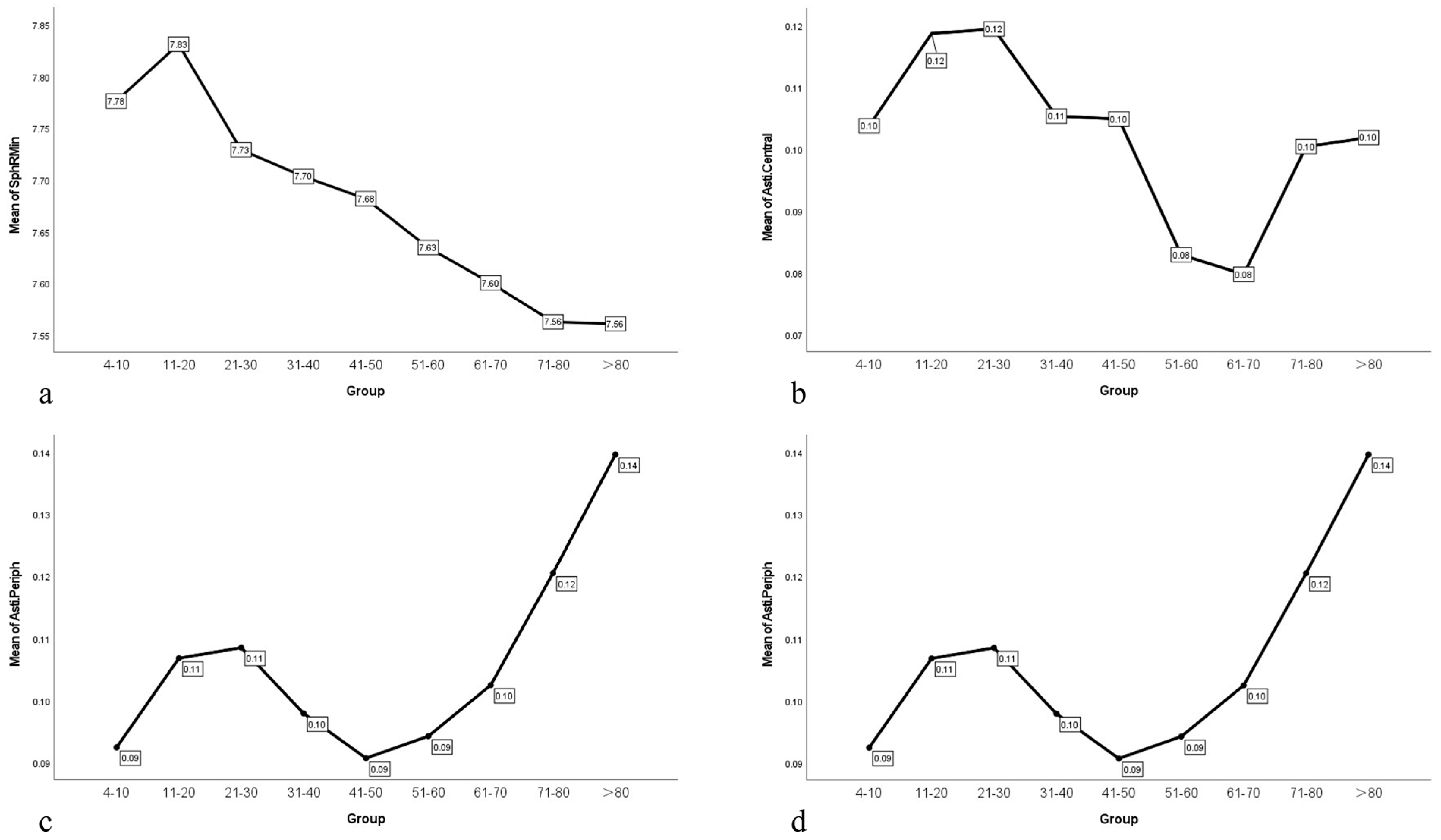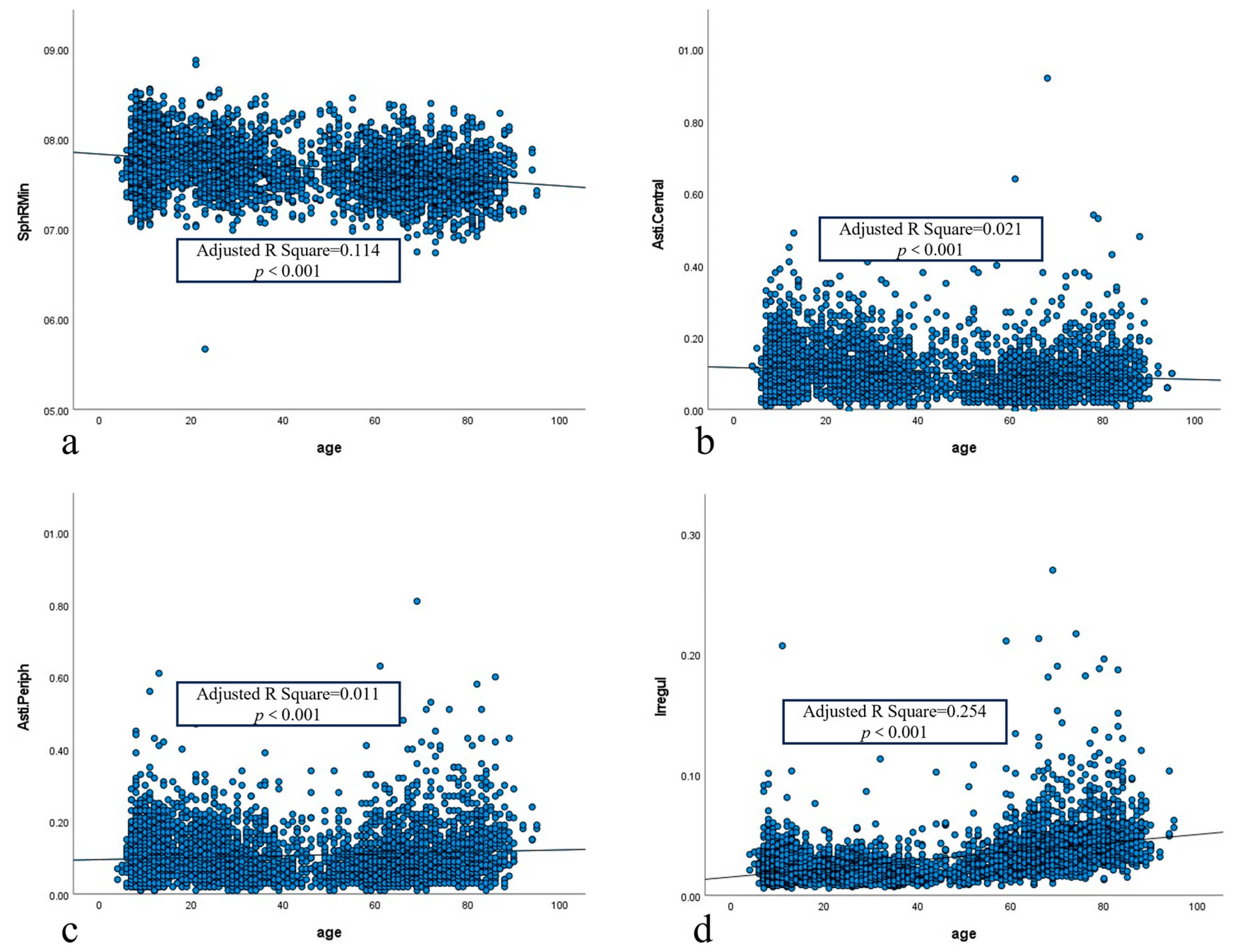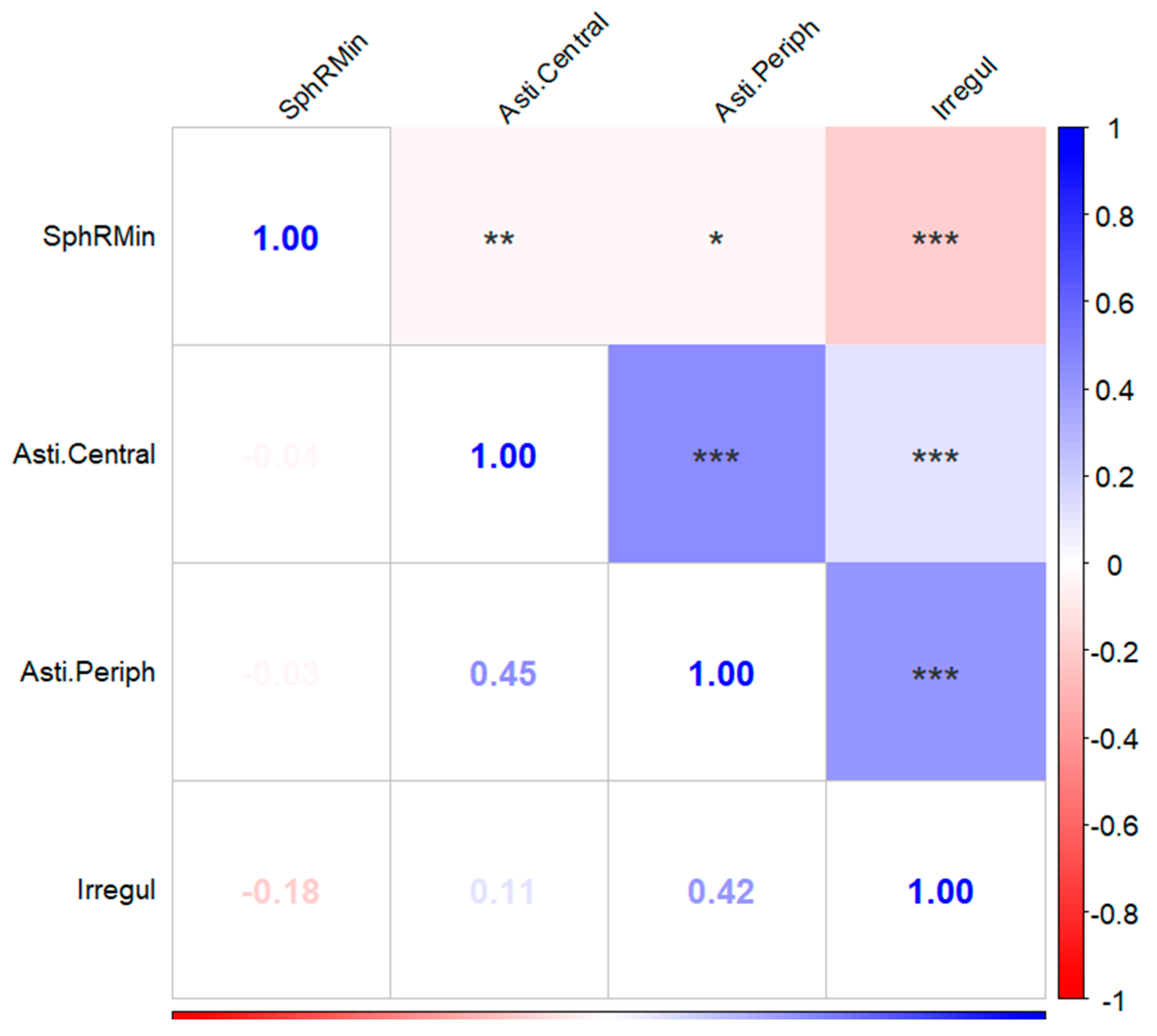Age-Related Trends in Corneal Refractive Parameters: A Fourier Analysis of Videokeratography in Healthy Eyes
Abstract
1. Introduction
2. Materials and Methods
2.1. Patients
2.2. Measurement of Corneal Fourier Parameters
2.3. Statistical Methods
3. Results
3.1. Mean and Range of Corneal Refractive Parameters in Normal Eyes at Different Ages
3.2. Corneal Refractive Changes with Age in Normal Eyes Assessed by Fourier Analysis
3.3. Correlation Between Corneal Refractive Parameters Obtained by Fourier Analysis
4. Discussion
Author Contributions
Funding
Institutional Review Board Statement
Informed Consent Statement
Data Availability Statement
Conflicts of Interest
References
- Li, L.; Gao, W.; Rao, F.; Tian, C.; Liang, S.; Wang, Y. Distribution of 50-layer corneal densitometry values and related factors. Int. Ophthalmol. 2023, 43, 3165–3173. [Google Scholar] [CrossRef]
- He, X.; He, Q.; Yuan, M.; Fang, Z.; Zhang, K.; Zhu, T.; Han, W. Evaluation of morphological features: Femtosecond-LASIK flap vs. SMILE cap, and the effects on corneal higher-order aberrations. Graefes Arch. Clin. Exp. Ophthalmol. 2022, 260, 3993–4003. [Google Scholar] [CrossRef] [PubMed]
- Keller, P.; van Saarloos, P. Fourier transformation of corneal topography data. Aust. N. Z. J. Ophthalmol. 1997, 25, 53–55. [Google Scholar] [CrossRef] [PubMed]
- Oie, Y.; Yasukura, Y.; Nishida, N.; Koh, S.; Kawasaki, R.; Maeda, N.; Jhanji, V.; Nishida, K. Fourier Analysis on Regular and Irregular Astigmatism of Anterior and Posterior Corneal Surfaces in Fuchs Endothelial Corneal Dystrophy. Am. J. Ophthalmol. 2021, 223, 33–41. [Google Scholar] [CrossRef]
- Gindina, S.; Kang, J.J.; Jacobs, D.S. Scleral lenses for correction of irregular astigmatism: Advances and limitations. Curr. Opin. Ophthalmol. 2025, 36, 282–287. [Google Scholar] [CrossRef]
- Olsen, T.; Dam-Johansen, M.; Bek, T.; Hjortdal, J.Ø. Evaluating surgically induced astigmatism by Fourier analysis of corneal topography data. J. Cataract. Refract. Surg. 1996, 22, 318–323. [Google Scholar] [CrossRef] [PubMed]
- Hayashi, K.; Hayashi, H.; Oshika, T.; Hayashi, F. Fourier analysis of irregular astigmatism after implantation of 3 types of intraocular lenses. J. Cataract. Refract. Surg. 2000, 26, 1510–1516. [Google Scholar] [CrossRef]
- Bandlitz, S.; Esper, P.; Stein, M.; Dautzenberg, T.; Wolffsohn, J.S. Corneoscleral Topography Measured with Fourier-based Profilometry and Scheimpflug Imaging. Optom. Vis. Sci. 2020, 97, 766–774. [Google Scholar] [CrossRef]
- Maeno, S.; Koh, S.; Inoue, R.; Oie, Y.; Maeda, N.; Jhanji, V.; Nishida, K. Fourier Analysis on Irregular Corneal Astigmatism Using Optical Coherence Tomography in Various Severity Stages of Keratoconus. Am. J. Ophthalmol. 2022, 243, 55–65. [Google Scholar] [CrossRef]
- Sideroudi, H.; Labiris, G.; Georgatzoglou, K.; Ditzel, F.; Siganos, C.; Kozobolis, V. Fourier analysis of videokeratography data: Clinical usefulness in grade I and subclinical keratoconus. J. Cataract. Refract. Surg. 2016, 42, 731–737. [Google Scholar] [CrossRef]
- Koh, S.; Maeda, N.; Ogawa, M.; Asonuma, S.; Takai, Y.; Maruyama, K.; Klyce, S.D.; Nishida, K. Fourier Analysis of Corneal Irregular Astigmatism Due to the Anterior Corneal Surface in Dry Eye. Eye Contact Lens 2019, 45, 188–194. [Google Scholar] [CrossRef]
- Minami, K.; Miyata, K.; Otani, A.; Tokunaga, T.; Tokuda, S.; Amano, S. Detection of increase in corneal irregularity due to pterygium using Fourier series harmonic analyses with multiple diameters. Jpn. J. Ophthalmol. 2018, 62, 342–348. [Google Scholar] [CrossRef]
- Tomidokoro, A.; Soya, K.; Miyata, K.; Armin, B.; Tanaka, S.; Amano, S.; Oshika, T. Corneal irregular astigmatism and contrast sensitivity after photorefractive keratectomy. Ophthalmology 2001, 108, 2209–2212. [Google Scholar] [CrossRef] [PubMed]
- Wang, L.; Dixit, L.; Weikert, M.P.; Jenkins, R.B.; Koch, D.D. Healing changes in clear corneal cataract incisions evaluated using Fourier-domain optical coherence tomography. J. Cataract. Refract. Surg. 2012, 38, 660–665. [Google Scholar] [CrossRef] [PubMed]
- Yamamoto, R.; Ono, T.; Toyono, T.; Shirakawa, R.; Noda, M.; Yoshida, J.; Miyai, T. Assessment of long-term anterior and posterior topographic changes in the cornea after ptosis surgery using Fourier harmonic analysis. Cornea 2021, 40, 440–444. [Google Scholar] [CrossRef] [PubMed]
- Chen, L.W.; Ono, T.; Hashimoto, Y.; Tsuneya, M.; Abe, Y.; Omoto, T.; Taketani, Y.; Toyono, T.; Aihara, M.; Miyai, T. Regular and irregular astigmatism of bullous keratopathy using Fourier harmonic analysis with anterior segment optical coherence tomography. Sci. Rep. 2022, 12, 17865. [Google Scholar] [CrossRef]
- Namba, H.; Sugano, A.; Murakami, T.; Utsunomiya, H.; Nishitsuka, K.; Ishizawa, K.; Kayama, T.; Yamashita, H. Age-Related Changes in Astigmatism and Potential Causes. Cornea 2020, 39, S34–S38. [Google Scholar] [CrossRef]
- Ma, R.; Liu, Y.; Zhang, L.; Ma, J.; Cui, T.; Lei, Y.; Hou, J.; Shen, Z.; Yi, X.; Liang, G.; et al. Changes in Corneal Morphology with Age in Asian Population: A Multicenter Study of 30,618 Cases. Adv. Ther. 2021, 38, 5763–5776. [Google Scholar] [CrossRef]
- Karmiris, E.; Soulantzou, K.; Machairoudia, G.; Ntravalias, T.; Tsiogka, A.; Chalkiadaki, E. Corneal Densitometry Assessed with Scheimpflug Camera in Healthy Corneas and Correlation with Specular Microscopy Values and Age. Cornea 2022, 41, 60–68. [Google Scholar] [CrossRef]
- Tanabe, T.; Tomidokoro, A.; Samejima, T.; Miyata, K.; Sato, M.; Kaji, Y.; Oshika, T. Corneal regular and irregular astigmatism assessed by Fourier analysis of videokeratography data in normal and pathologic eyes1 1None of the authors has a proprietary interest in any material or method mentioned. Ophthalmology 2004, 111, 752–757. [Google Scholar] [CrossRef]
- Asgari, S.; Hashemi, H.; Mehravaran, S.; Khabazkhoob, M.; Emamian, M.H.; Jafarzadehpur, E.; Shariati, M.; Fotouhi, A. Corneal Refractive Power and Eccentricity in the 40- to 64-Year-Old Population of Shahroud, Iran. Cornea 2013, 32, 25–29. [Google Scholar] [CrossRef]
- KhabazKhoob, M.; Hashemi, H.; Yazdani, K.; Mehravaran, S.; Yekta, A.; Fotouhi, A. Keratometry measurements, corneal astigmatism and irregularity in a normal population: The Tehran Eye Study. Ophthalmic Physiol. Opt. 2010, 30, 800–805. [Google Scholar] [CrossRef]
- Sweeney, D.F.; Millar, T.J.; Raju, S.R. Tear film stability: A review. Exp. Eye Res. 2013, 117, 28–38. [Google Scholar] [CrossRef] [PubMed]
- Jiang, Y.; Chen, X.; Gao, Y.; Gao, N.; Wang, H.; Feng, Y.; Li, M.; Qin, L.; Li, F.; Zhao, S.; et al. Impact of tear film stability on corneal refractive power measurement and surgical planning for cataract. Adv. Ophthalmol. Pract. Res. 2025, 5, 100–106. [Google Scholar] [CrossRef] [PubMed]
- Sharifi, A.; Zand, A.; Shafiei, M.; Nasiri, N.; Sharifi, H.; Najafzadeh, M.J.; Sharifi, M. The influence of age and gender on ocular biometrics and corneal astigmatism in adults undergoing cataract surgery. Sage Open Med. 2024, 12, 20503121241282956. [Google Scholar] [CrossRef]
- Uçakhan, Ö.Ö.; Yeşiltaş, Y.S. Correction of Irregular Astigmatism with New-Generation Hybrid Contact Lenses. Eye Contact Lens 2020, 46, 91–98. [Google Scholar] [CrossRef]
- Jinabhai, A.; Radhakrishnan, H.; O’Donnell, C. Visual acuity and ocular aberrations with different rigid gas permeable lens fittings in keratoconus. Eye Contact Lens 2010, 36, 233–237. [Google Scholar] [CrossRef] [PubMed]
- Goto, T.; Klyce, S.D.; Zheng, X.; Maeda, N.; Kuroda, T.; Ide, C. Gender- and Age-related Differences in Corneal Topography. Cornea 2001, 20, 270–276. [Google Scholar] [CrossRef]
- Ueno, Y.; Nomura, R.; Hiraoka, T.; Kinoshita, K.; Ohara, M.; Oshika, T. Comparison of corneal irregular astigmatism by the type of corneal regular astigmatism. Sci. Rep. 2021, 11, 15769. [Google Scholar] [CrossRef]
- Oshika, T.; Tomidokoro, A.; Maruo, K.; Tokunaga, T.; Miyata, N. Quantitative evaluation of irregular astigmatism by fourier series harmonic analysis of videokeratography data. Investig. Ophthalmol. Vis. Sci. 1998, 39, 705–709. [Google Scholar]




| Spherical equivalent | Zero frequency component | n = 0 |
| Decentration | One-cycle component | n = 1 |
| Regular astigmatism | Two-cycle component | n = 2 |
| Irregular astigmatism | Higher-order components | n = 3 |
| Group | 1 | 2 | 3 | 4 | 5 | 6 | 7 | 8 | 9 | |||
|---|---|---|---|---|---|---|---|---|---|---|---|---|
| Age range | 1–10 | 11–20 | 21–30 | 31–40 | 41–50 | 51–60 | 61–70 | 71–80 | 81–95 | p value | Padj value * | |
| n | 488 | 549 | 337 | 169 | 73 | 176 | 351 | 243 | 168 | |||
| Eyes | 971 | 1095 | 674 | 335 | 145 | 348 | 699 | 479 | 328 | |||
| Right eyes/all eyes | 50.3% | 49.9% | 50.0% | 49.6% | 50.3% | 49.4% | 50.2% | 49.3% | 48.8% | 0.374 | 1.00 | 1.00 |
| Group | n | SphRMin (mm) | Asti.Central (D) | Asti.Periph (D) | Irregul (D) | ||||
|---|---|---|---|---|---|---|---|---|---|
| Mean ± SD | Range | Mean ± SD | Range | Mean ± SD | Range | Mean ± SD | Range | ||
| 1 | 971 | 7.78 ± 0.26 | 7.03–8.53 | 0.10 ± 0.053 | 0.01–0.39 | 0.092 ± 0.057 | 0.01–0.45 | 0.022 ± 0.0099 | 0.0060–0.10 |
| 2 | 1095 | 7.83 ± 0.25 | 7.03–8.56 | 0.19 ± 0.061 | 0.01–0.49 | 0.11 ± 0.063 | 0.01–0.61 | 0.022 ± 0.011 | 0.0060–0.21 |
| 3 | 674 | 7.73 ± 0.28 | 5.67–8.88 | 0.12 ± 0.064 | 0.00–0.41 | 0.11 ± 0.063 | 0.01–0.47 | 0.020 ± 0.0083 | 0.0060–0.086 |
| 4 | 335 | 7.70 ± 0.26 | 7.07–8.48 | 0.11 ± 0.05 | 0.01–0.36 | 0.098 ± 0.063 | 0.01–0.39 | 0.020 ± 0.0096 | 0.0070–0.11 |
| 5 | 145 | 7.68 ± 0.28 | 7.11–8.39 | 0.10 ± 0.066 | 0.01–0.38 | 0.09 ± 0.059 | 0.01–0.34 | 0.022 ± 0.013 | 0.0080–0.10 |
| 6 | 348 | 7.63 ± 0.27 | 6.98–8.46 | 0.083 ± 0.058 | 0.01–0.40 | 0.09 ± 0.064 | 0.01–0.51 | 0.029 ± 0.017 | 0.0080–0.21 |
| 7 | 699 | 7.60 ± 0.26 | 6.75–8.39 | 0.080 ± 0.061 | 0.00–0.92 | 0.10 ± 0.073 | 0.01–0.81 | 0.038 ± 0.022 | 0.0090–0.27 |
| 8 | 479 | 7.56 ± 0.28 | 6.74–8.40 | 0.10 ± 0.068 | 0.01–0.54 | 0.12 ± 0.082 | 0.01–0.53 | 0.046 ± 0.025 | 0.013–0.22 |
| 9 | 328 | 7.56 ± 0.26 | 6.92–8.29 | 0.10 ± 0.065 | 0.01–0.48 | 0.14 ± 0.087 | 0.01–0.60 | 0.050 ± 0.023 | 0.015–0.19 |
| Total | 5074 | 7.71 ± 0.28 | 5.67–8.88 | 0.10 ± 0.062 | 0.00–0.92 | 0.11 ± 0.068 | 0.01–0.81 | 0.028 ± 0.019 | 0.0060–0.27 |
Disclaimer/Publisher’s Note: The statements, opinions and data contained in all publications are solely those of the individual author(s) and contributor(s) and not of MDPI and/or the editor(s). MDPI and/or the editor(s) disclaim responsibility for any injury to people or property resulting from any ideas, methods, instructions or products referred to in the content. |
© 2025 by the authors. Licensee MDPI, Basel, Switzerland. This article is an open access article distributed under the terms and conditions of the Creative Commons Attribution (CC BY) license (https://creativecommons.org/licenses/by/4.0/).
Share and Cite
Tan, S.; Liu, Z.; Li, Y.; Li, X.; Tong, Y.; Li, X. Age-Related Trends in Corneal Refractive Parameters: A Fourier Analysis of Videokeratography in Healthy Eyes. Biomedicines 2025, 13, 2740. https://doi.org/10.3390/biomedicines13112740
Tan S, Liu Z, Li Y, Li X, Tong Y, Li X. Age-Related Trends in Corneal Refractive Parameters: A Fourier Analysis of Videokeratography in Healthy Eyes. Biomedicines. 2025; 13(11):2740. https://doi.org/10.3390/biomedicines13112740
Chicago/Turabian StyleTan, Shumei, Ziyuan Liu, Yuanting Li, Xiang Li, Yicheng Tong, and Xuemin Li. 2025. "Age-Related Trends in Corneal Refractive Parameters: A Fourier Analysis of Videokeratography in Healthy Eyes" Biomedicines 13, no. 11: 2740. https://doi.org/10.3390/biomedicines13112740
APA StyleTan, S., Liu, Z., Li, Y., Li, X., Tong, Y., & Li, X. (2025). Age-Related Trends in Corneal Refractive Parameters: A Fourier Analysis of Videokeratography in Healthy Eyes. Biomedicines, 13(11), 2740. https://doi.org/10.3390/biomedicines13112740






